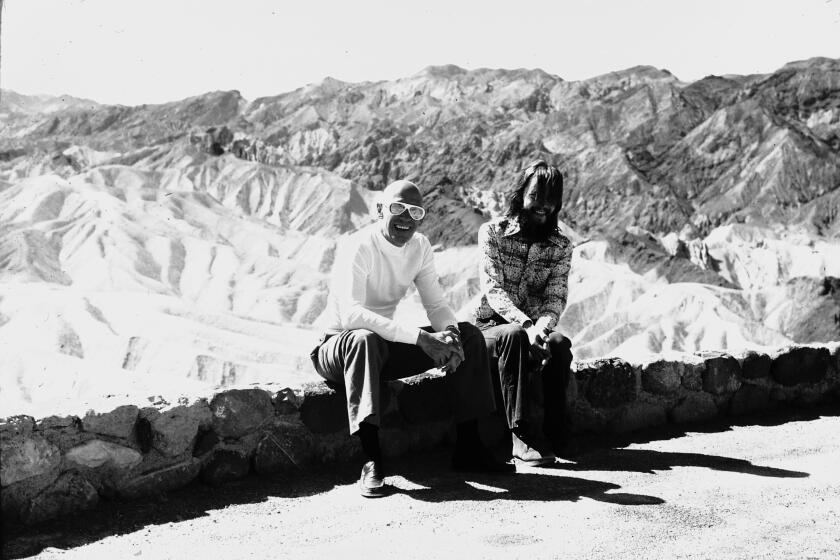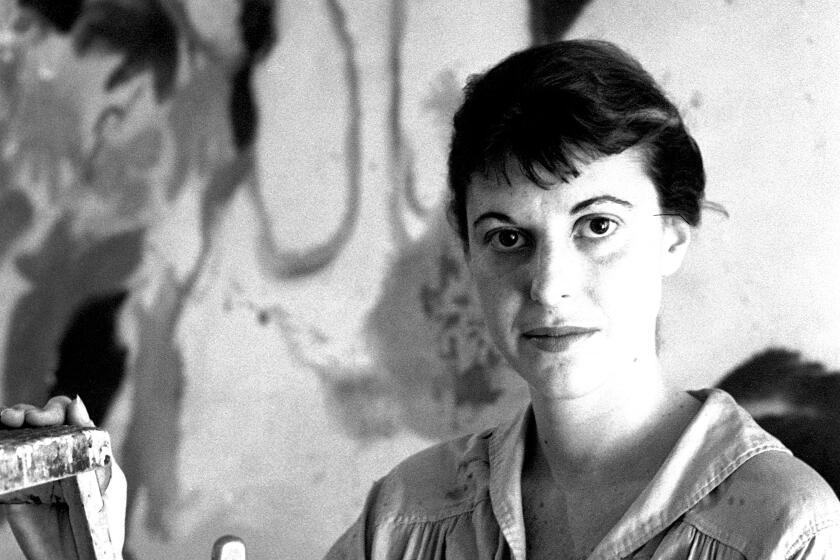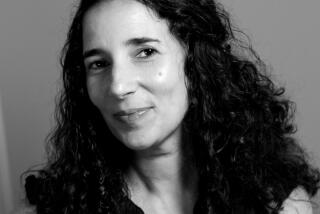‘Survival energy’: How COVID-19 and pregnancy fueled a fierce new book

On the Shelf
To Write as if Already Dead
By Kate Zambreno
Columbia: 176 pages, $22
If you buy books linked on our site, The Times may earn a commission from Bookshop.org, whose fees support independent bookstores.
When French writer and photographer Hervé Guibert was diagnosed with AIDS in 1988, he was already prolific. But when he published his novel “To the Friend Who Did Not Save My Life” in 1990, revealing his positive status and that of his friend, the late Michel Foucault, Guibert became newly famous. Possessed by a kind of “survival energy,” he had been determined to write as much of his life as he could before its end. In 1991, nearly blind, Guibert took an overdose and died two weeks later, just after his 36th birthday.
Kate Zambreno’s latest book, “To Write as if Already Dead,” is a study of Guibert’s uncompromising novel. Galvanized by much the same “survival energy,” the conversation vibrates with eerie coincidence: two writers amid the chaos of a pandemic, working against erasure.
Zambreno is as prolific and not yet famous as Guibert was before his diagnosis. She has often been called unconventional and experimental — the kind of writer whose Wikipedia page has a much longer section for “critical reception” than “career.” Like the writing of Maggie Nelson, Sarah Manguso and others testing the borders of essay, memoir and fiction, her work defies easy categorization.
Zambreno’s blog, Frances Farmer Is My Sister, became the book “Heroines,” published in 2012, on the “mad wives” of modernist literature: Vivienne Eliot, Jane Bowles, Jean Rhys and Zelda Fitzgerald. Among her novels and essays, Zambreno published “Book of Mutter” in 2017, on the death of her mother. “To Write as if Already Dead” is her 8th book and her fourth to be published since 2019.
“Looking back on it, especially through the last two books, I’m thinking of all the ways I’ve destroyed my body trying to finish books,” Zambreno says, laughing with exasperation during a phone call from her home in New York. Her last book, “Drifts,” was released in the early months of the COVID-19 pandemic. In it, she wrote, “Every book I’ve published embarrasses me.”
After almost a decade under contract, “Drifts,” about writing and Rainer Maria Rilke, was completed after Zambreno gave birth to her first child. “To Write as if Already Dead” followed a similar trajectory — completed after many years of rumination in a mad dash fueled by a second pregnancy and the pandemic.
In “The Last Man Takes LSD,” two authors track Foucault’s late-in-life rightward turn, beginning with a hallucinogenic 1975 visit to Death Valley.
“So much of the book is about urgency,” Zambreno said. “I knew I wasn’t getting maternity leave; I had a real panic that if I didn’t write it then, it wouldn’t get written. I’ve lost books like that before; the window will go away.”
There is a literal sense of the word “deadline” in the new book, as signaled by its title and subject. “Is this why I’m writing so much? This drive? Is it fear? Hypochondriac energy? The desire to write all the books I have planned, as quickly as possible . . . As a way to exist?” she writes.
Zambreno’s process brings to mind pregnancy and childbirth. “Francis Bacon said that he was overcome by despair and then he would work,” she says. “That’s a good description ... I often commit these crazy bodily acts like making myself sick because that’s when I get the writing done. Those hours come at quite a cost.”

While thinking about Guibert, Zambreno was going into Manhattan for ob-gyn check-ups just as COVID-19 deaths peaked in New York — “commuting to Mt. Sinai, feeling this insane sense of dread, with all the ambulances,” she remembers. “But rather than panicking, the Guibert allowed me to work through the present moment.”
Much of the dehumanizing “medical gaze” Guibert describes resonates with what Zambreno has endured postpartum. The cruelty of the healthcare system plays a major part in both books, especially during the pandemic. Having just won a fellowship from the Guggenheim Foundation, Zambreno tells me that the funds equal two years of family healthcare. The money is going straight to insurance.
The postpartum experience isn’t just expensive; it can also be one of psychic trauma and creative crisis. Someone who was a person becomes a mother. “You’re not a person. You don’t have a name,” says Zambreno. This feeling of erasure is a current that runs through her work, reaching peak intensity in “To Write as if Already Dead.” “I need to restore myself after being made into a ghost,” Zambreno says. “I always feel like writing the most when I’m being made invisible.”
It must be said that Guibert’s was a “much more dire diagnosis.” Giving birth is not the horror or suffering of AIDS or COVID-19. When I asked Zambreno why she was drawn to queer men, she acknowledged having heard the question before. An artist friend had asked her: “Do you think it has to do with feminist writing’s refusal to recognize abject bodies?”
In Lynn Steger Strong’s ‘Want,’ a writer, teacher and mother faces up to her own privilege and the precariousness of her middle-class life.
Other writers have recently questioned the impact of motherhood on art — for instance, Sheila Heti in “Motherhood.” Zambreno welcomes more writing and thinking about its costs. “The philosophy of motherhood has only just begun,” she said. “It is overwritten in cliché and underwritten in despair.” Guibert, in a journal about a harrowing hospital stay, quoted Virginia Woolf’s “On Being Ill”: “But of all this daily drama of the body, there is no record.”
At the end of “To Write as if Already Dead,” Zambreno imagines Guibert in his last months, “always writing, or trying to write. As a way to prevent death? As a way to look it in the eye? I wonder if death is the ultimate betrayal, not writing.”
Pregnancy and childbirth can have analogous effects on the artist. “Literature is time, writing is time,” Zambreno tells me. Now the mother of two children, “I feel very jealous of whoever wrote ‘Drifts.’ I will never have that time again.”
COVID-19 provides the framework for the second part of Zambreno’s book, but it begins with a very different theme: creative collaboration. The author opens with an appreciation for the friendships she made with other writers online. “I think of ‘Drifts’ and ‘To Write’ as love letters to women and nonbinary writers who I correspond with,” she says, “chance encounters that catalyzed my thinking and who I am.”
I told Zambreno that I was startled to discover the book is dedicated to Bhanu Kapil, who coined the term “survival energy.” I had picked up Kapil’s book, “The Vertical Interrogation of Strangers,” just a few weeks earlier. She laughed.
“I love the idea of what you’re reading, how that becomes an intimacy,” she said. For Zambreno, that’s the goal of writing, “being alive with the uncanniness and spookiness of literature [and] the profound connection of communities.”
Andrew Nemerov’s ‘Fierce Poise: Helen Frankenthaler and 1950s New York’ charts the rise of an Abstract Expressionist painter knocked for her privilege.
Guibert ends “To the Friend Who Did Not Save My Life” by writing, “my book is closing in on me.” His work was a postcard from the edge, but luckily, Zambreno isn’t finished. Her communion with Guibert not only illuminates his work; it also gives the living author the tools to “write as if already dead.” In “Drifts,” she quotes a letter from Rilke to Auguste Rodin that might hold the key to her drive: “To work is to live without dying.”
Ferri’s most recent book is “Silent Cities: New York.”
More to Read
Sign up for our Book Club newsletter
Get the latest news, events and more from the Los Angeles Times Book Club, and help us get L.A. reading and talking.
You may occasionally receive promotional content from the Los Angeles Times.








